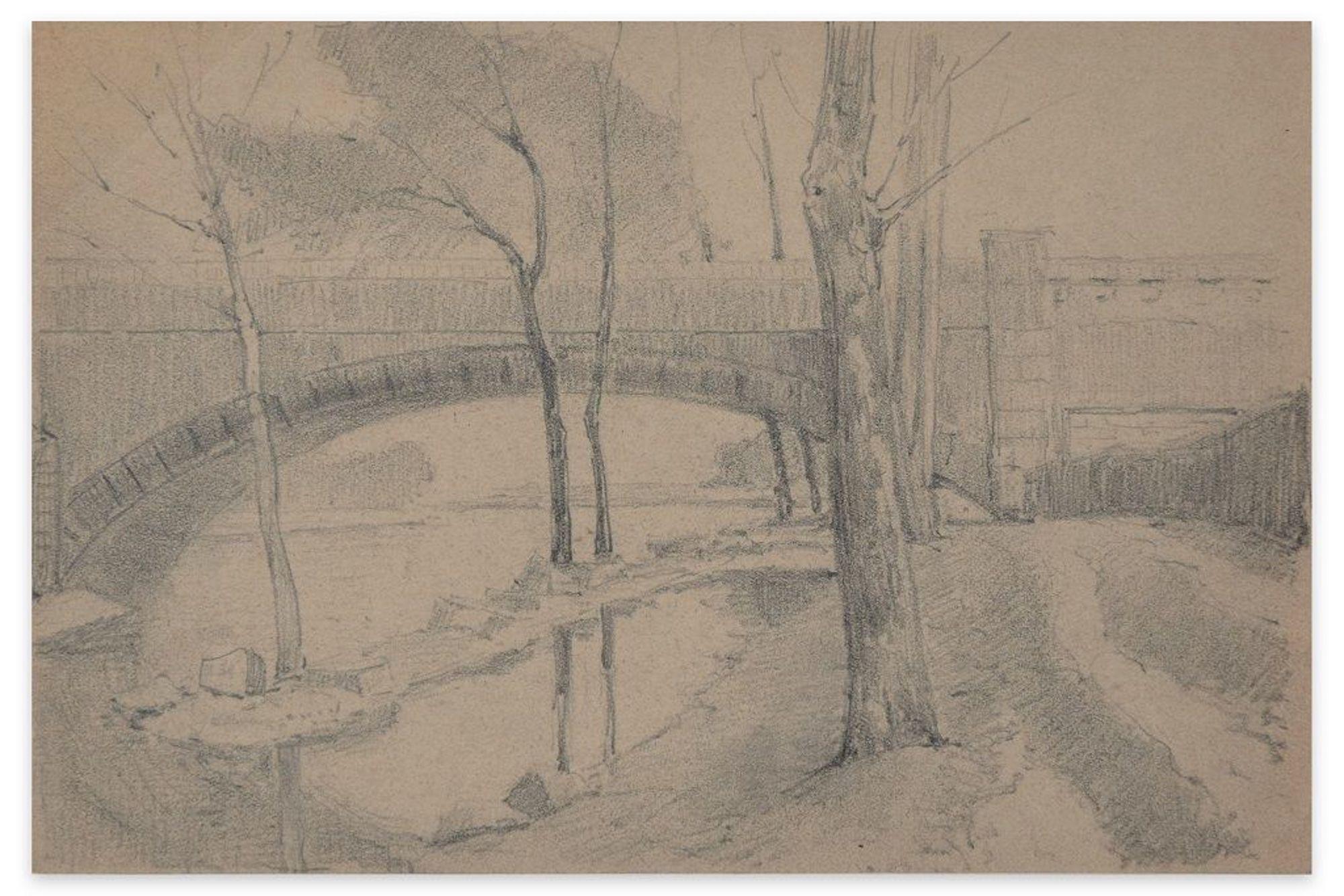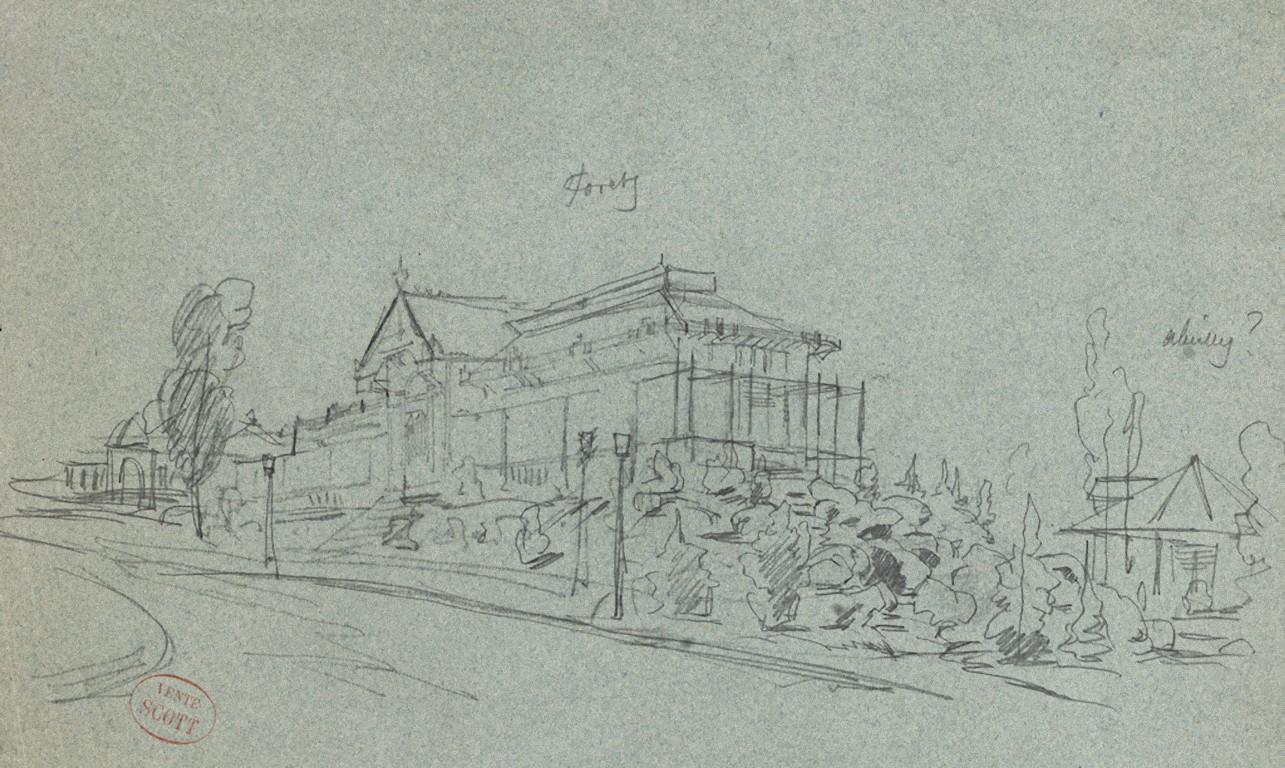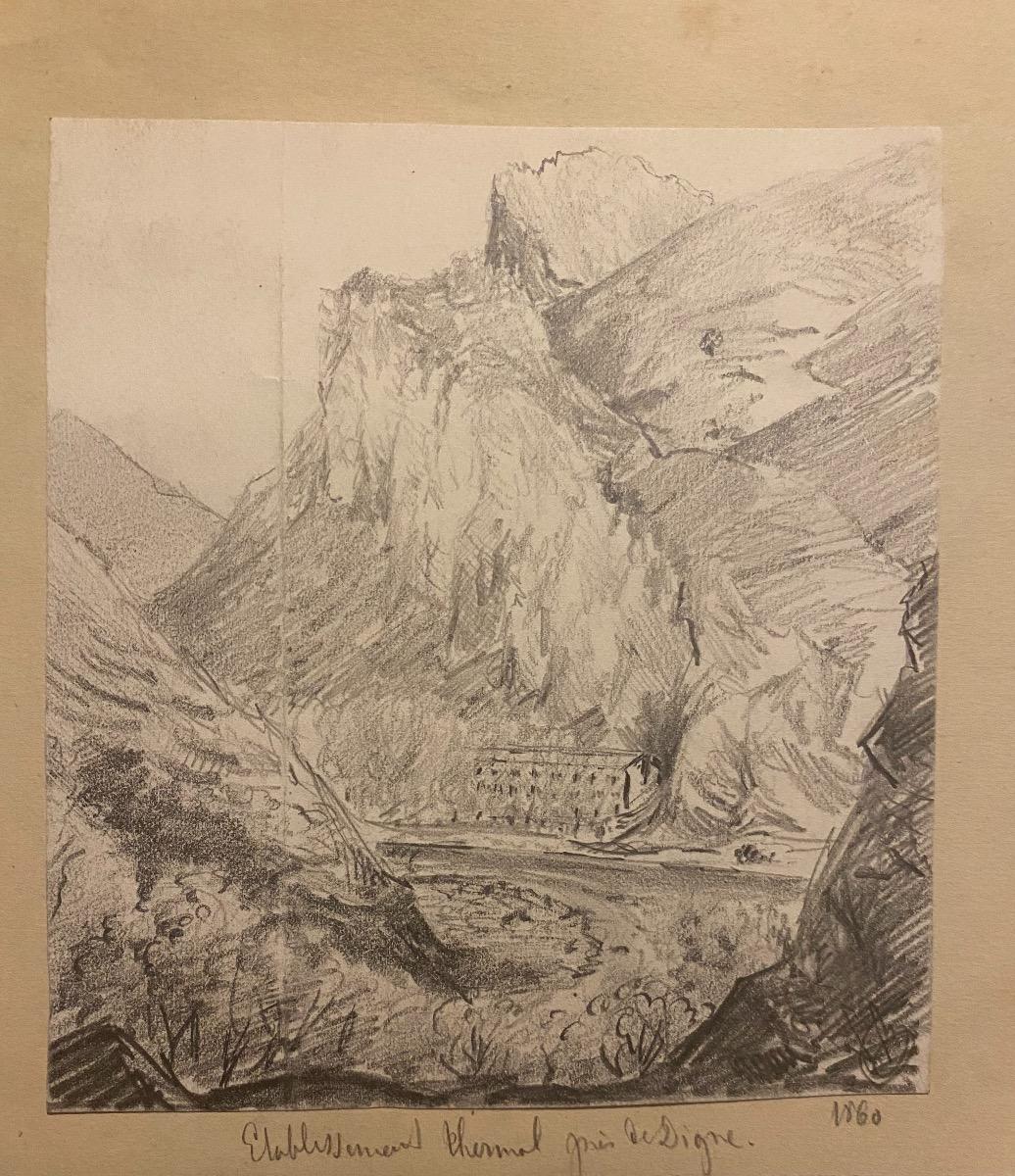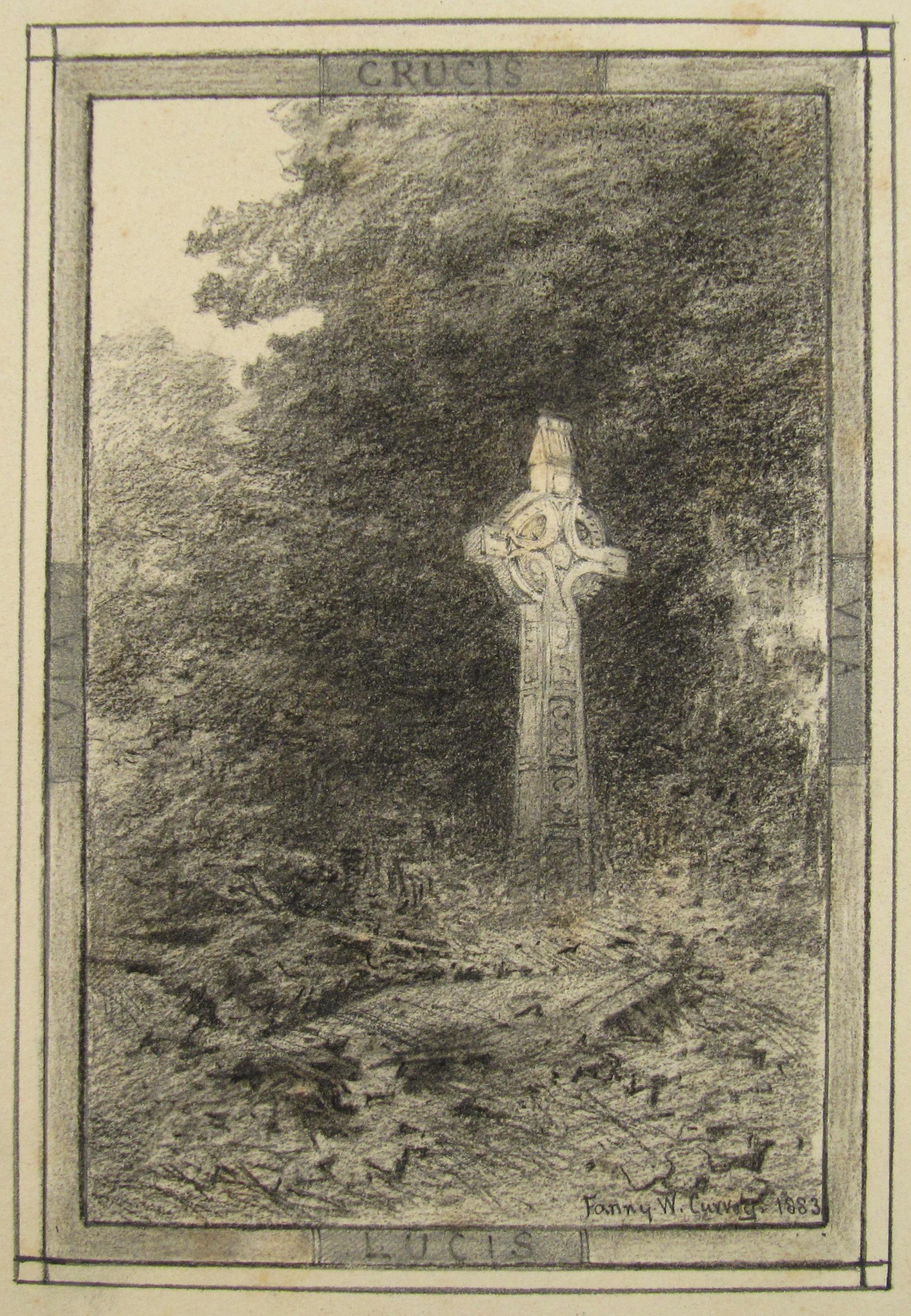Items Similar to Tree and House - Charcoal by E.-L. Minet - Early 1900
Want more images or videos?
Request additional images or videos from the seller
1 of 2
Emile-Louis MinetTree and House - Charcoal by E.-L. Minet - Early 1900Early 20th Century
Early 20th Century
About the Item
Tree and House is a precious pencil study realized by the French painter Emile-Louis Minet. The state of preservation is excellent. The piece of paper comes from a sketchbook, and it presents some fringes on the higher margin.
Louis Minet was an important artist from Normandy. He lived in Rouen, where he studied at the Ecole des Beaux-Arts. During his life, he achieved great success and won a mention of honor at the Salon of French Artists in 1882. In 1917, he was elected member of the Academy of Sciences and Fine Arts of Rouen and in 1905 curator of the Museum of Fine Arts of Rouen until 1922.
This artwork represents a big bare tree in the foreground near a path and a big house with a roof terrace behind it, typical of French countryside buildings. The artist was a realist painter, who paid much attention to air, light, and atmosphere. He drew inspiration from the landscapes and countryside of Normandy en plen air, as it probably occurred in this precise and dynamic drawing, typical of this artist’s production and of coeval painting.
- Creator:Emile-Louis Minet (1841 - 1923)
- Creation Year:Early 20th Century
- Dimensions:Height: 4.93 in (12.5 cm)Width: 8.15 in (20.7 cm)Depth: 0.04 in (1 mm)
- Medium:
- Movement & Style:
- Period:
- Condition:Insurance may be requested by customers as additional service, contact us for more information.
- Gallery Location:Roma, IT
- Reference Number:
About the Seller
4.9
Platinum Seller
These expertly vetted sellers are 1stDibs' most experienced sellers and are rated highest by our customers.
1stDibs seller since 2017
6,717 sales on 1stDibs
Typical response time: 2 hours
- ShippingRetrieving quote...Ships From: Monaco, Monaco
- Return PolicyA return for this item may be initiated within 14 days of delivery.
More From This SellerView All
- Bridge on the River - Charcoal and Pencil by E.-L. Minet - 1919By Emile-Louis MinetLocated in Roma, ITBridge on the River is a beautiful drawing in pencil and charcoal realized by the French painter Emile-Louis Minet in 1919. The state of preservation is very good, except for a small...Category
1910s Naturalistic Landscape Drawings and Watercolors
MaterialsPencil, Charcoal
- Villa - Original Pencil on paper - 20th CenturyLocated in Roma, ITVilla is an original drawing in pencil on paper, realized by an Anonymous artist of the XX century, with the stamp of "Vente Scott" in red on the lower left. The State of preservati...Category
20th Century Naturalistic Figurative Drawings and Watercolors
MaterialsPencil
- Etablissement Thérmal près de Digne - Original Pencil On Paper - 1860Located in Roma, ITEtablissement Thérmal press de Digne is an original pencil drawing glued on ivory paper by Anonymous Artist in 1860. In very good condition. Not signed. Notes of the artist on the ...Category
1860s Naturalistic Figurative Drawings and Watercolors
MaterialsPencil
- The Cityscape of Ardenza, Livorno - Original Pencil Drawing - 1870Located in Roma, ITThe cityscape of Ardenza, Livorno is an original drawing in pencil on paper realized in 1870 by an Anonymous artist of the 19th century. Titled and dated at the top center. The st...Category
1870s Naturalistic Figurative Drawings and Watercolors
MaterialsPencil
- Trees - Original Watercolor - 1950sBy André Roland BrudieuxLocated in Roma, ITTrees is an original watercolor drawing, realized by André Roland Brudieux in 1950s. The state of preservation of the artwork is very good and aged. Sheet dimension: 37.5 x 32.5 cm....Category
1950s Naturalistic Figurative Drawings and Watercolors
MaterialsWatercolor
- Beach - Original Drawing in Pen by Jeanne le Soudiere - 20th CenturyLocated in Roma, ITBeach is a beautiful drawing in pen realized by the artist Jeanne le Soudiere. Hand-signed on the lower left. The state of preservation is excellent. The artwork represents a beac...Category
20th Century Naturalistic Figurative Drawings and Watercolors
MaterialsPen
You May Also Like
- Paul Schürch (1886-1939) - Romantic Landscape Drawing 1917 Solothurn SwitzerlandLocated in Meinisberg, CHPaul Schürch (Swiss, ∗ 14.2.1886 Wangen b. Olten, † 11.12.1939 Bern) Romantic Landscape in area of Solothurn, Switzerland • Charcoal/Pencil drawing delicately heightened in various...Category
1910s Naturalistic Landscape Drawings and Watercolors
MaterialsLaid Paper, Pencil, Pastel, Charcoal
- Fanny W. Currey ( Ireland ) 19thC Drawing of Celtic Cross - Via Crucis Via LucisLocated in Meinisberg, CHFanny Wimot Currey (Irish, 1848 - 1917) Via Crucis Via Lucis • Pencil on paper ca. 31 x 25 cm • Signed & dated lower right 1883 • The sheet measures ca. 31.2 x 23.2 cm • The image ...Category
1880s Naturalistic Figurative Drawings and Watercolors
MaterialsPaper, Pencil
- America's Cup - 1967. Wing Mark, Intrepid and Dame Pattie.By Joseph Webster GolinkinLocated in New York, NYAMERICA'S CUP - 1967. WING MARK. INTREPID - DAME PATTIE [AUS]. This Joseph Webster Golinkin watercolor of the 1967 America's Cup depicts the...Category
1960s Naturalistic Landscape Drawings and Watercolors
MaterialsWatercolor
- The Lumber WharfBy Gordon GrantLocated in New York, NYGordon Hope Grant (1875-1962) created the watercolor entitled “The Lumber Wharf” in circa 1947. It is signed in the lower left 1 inch above the paper edge. The watercolor paper size ...Category
1940s Naturalistic Landscape Drawings and Watercolors
MaterialsWatercolor
- Whimsical Illustration Hiking Cartoon, 1938 Mt Tremblant Ski Lodge William SteigBy William Steig (b.1907)Located in Surfside, FLLighthearted Illustration of Outdoor Pursuits This one being cross country hiking signed "W. Steig" Provenance: from Mrs. Joseph B. Ryan, Commissioned by Joe Ryan for the bar at his ski resort, Mount Tremblant Lodge, in 1938. Mont Tremblant, P.Q., Canada Watercolor and ink on illustration board, sights sizes 8 1/2 x 16 1/2 in., framed. In 1938 Joe Ryan, described as a millionaire from Philadelphia, bushwhacked his way to the summit of Mont Tremblant and was inspired to create a world class ski resort at the site. In 1939 he opened the Mont Tremblant Lodge, which remains part of the Pedestrian Village today. This original illustration is on Whatman Illustration board. the board measures 14 X 22 inches. label from McClees Galleries, Philadelphia, on the frame backing paper. William Steig, 1907 – 2003 was an American cartoonist, sculptor, and, in his later life, an illustrator and writer of children's books. Best known for the picture books Sylvester and the Magic Pebble, Abel's Island, and Doctor De Soto, he was also the creator of Shrek!, which inspired the film series of the same name. He was the U.S. nominee for both of the biennial, international Hans Christian Andersen Awards, as a children's book illustrator in 1982 and a writer in 1988. Steig was born in Brooklyn, New York in 1907, and grew up in the Bronx. His parents were Polish-Jewish immigrants from Austria, both socialists. His father, Joseph Steig, was a house painter, and his mother, Laura Ebel Steig, was a seamstress who encouraged his artistic leanings. As a child, he dabbled in painting and was an avid reader of literature. Among other works, he was said to have been especially fascinated by Pinocchio.He graduated from Townsend Harris High School at 15 but never completed college, though he attended three, spending two years at City College of New York, three years at the National Academy of Design and a mere five days at the Yale School of Fine Arts before dropping out of each. Hailed as the "King of Cartoons" Steig began drawing illustrations and cartoons for The New Yorker in 1930, producing more than 2,600 drawings and 117 covers for the magazine. Steig, later, when he was 61, began writing children's books. In 1968, he wrote his first children's book. He excelled here as well, and his third book, Sylvester and the Magic Pebble (1969), won the Caldecott Medal. He went on to write more than 30 children's books, including the Doctor DeSoto series, and he continued to write into his nineties. Among his other well-known works, the picture book Shrek! (1990) formed the basis for the DreamWorks Animation film Shrek (2001). After the release of Shrek 2 in 2004, Steig became the first sole-creator of an animated movie franchise that went on to generate over $1 billion from theatrical and ancillary markets after only one sequel. Along with Maurice Sendak, Saul Steinberg, Ludwig Bemelmans and Laurent de Brunhofff his is one of those rare cartoonist whose works form part of our collective cultural heritage. In 1984, Steig's film adaptation of Doctor DeSoto directed by Michael Sporn was nominated for the Academy Award for Best Animated Short Film. As one of the most admired cartoonists of all time, Steig spent seven decades drawing for the New Yorker magazine. He touched generations of readers with his tongue–in–cheek pen–and–ink drawings, which often expressed states of mind like shame, embarrassment or anger. Later in life, Steig turned to children's books, working as both a writer and illustrator. Steig's children's books were also wildly popular because of the crazy, complicated language he used—words like lunatic, palsied, sequestration, and cleave. Kids love the sound of those words even if they do not quite understand the meaning. Steig's descriptions were also clever. He once described a beached whale as "breaded with sand." Throughout the course of his career, Steig compiled his cartoons and drawings into books. Some of them were published first in the New Yorker. Others were deemed too dark to be printed there. Most of these collections centered on the cold, dark psychoanalytical truth about relationships. They featured husbands and wives fighting and parents snapping at their kids. His first adult book, Man About Town, was published in 1932, followed by About People, published in 1939, which focused on social outsiders. Sick of Each Other, published in 2000, included a drawing depicting a wife holding her husband at gunpoint, saying, "Say you adore me." According to the Los Angeles Times, fellow New Yorker artist Edward Sorel...Category
1930s Naturalistic Figurative Drawings and Watercolors
MaterialsArchival Ink, Watercolor, Illustration Board
- Whimsical Illustration Skiing Cartoon, 1938 Mt Tremblant Ski Lodge William SteigBy William Steig (b.1907)Located in Surfside, FLLighthearted Illustration of Outdoor Pursuits This one being a Skiing scene, a boy and a girl on skis. signed W. Steig Provenance: from Mrs. Joseph B. Ryan, Commissioned by Joe Ryan for the bar at his ski resort, Mount Tremblant Lodge, in 1938. Mont Tremblant, P.Q., Canada Watercolor and ink on illustration board, sights sizes 8 1/2 x 16 1/2 in., framed. In 1938 Joe Ryan, described as a millionaire from Philadelphia, bushwhacked his way to the summit of Mont Tremblant and was inspired to create a world class ski resort at the site. In 1939 he opened the Mont Tremblant Lodge, which remains part of the Pedestrian Village today. This original illustration is on Whatman Illustration board. the board measures 14 X 22 inches. label from McClees Galleries, Philadelphia, on the frame backing paper. William Steig, 1907 – 2003 was an American cartoonist, sculptor, and, in his later life, an illustrator and writer of children's books. Best known for the picture books Sylvester and the Magic Pebble, Abel's Island, and Doctor De Soto, he was also the creator of Shrek!, which inspired the film series of the same name. He was the U.S. nominee for both of the biennial, international Hans Christian Andersen Awards, as a children's book illustrator in 1982 and a writer in 1988. Steig was born in Brooklyn, New York in 1907, and grew up in the Bronx. His parents were Polish-Jewish immigrants from Austria, both socialists. His father, Joseph Steig, was a house painter, and his mother, Laura Ebel Steig, was a seamstress who encouraged his artistic leanings. As a child, he dabbled in painting and was an avid reader of literature. Among other works, he was said to have been especially fascinated by Pinocchio.He graduated from Townsend Harris High School at 15 but never completed college, though he attended three, spending two years at City College of New York, three years at the National Academy of Design and a mere five days at the Yale School of Fine Arts before dropping out of each. Hailed as the "King of Cartoons" Steig began drawing illustrations and cartoons for The New Yorker in 1930, producing more than 2,600 drawings and 117 covers for the magazine. Steig, later, when he was 61, began writing children's books. In 1968, he wrote his first children's book. He excelled here as well, and his third book, Sylvester and the Magic Pebble (1969), won the Caldecott Medal. He went on to write more than 30 children's books, including the Doctor DeSoto series, and he continued to write into his nineties. Among his other well-known works, the picture book Shrek! (1990) formed the basis for the DreamWorks Animation film Shrek (2001). After the release of Shrek 2 in 2004, Steig became the first sole-creator of an animated movie franchise that went on to generate over $1 billion from theatrical and ancillary markets after only one sequel. Along with Maurice Sendak, Saul Steinberg, Ludwig Bemelmans and Laurent de Brunhofff his is one of those rare cartoonist whose works form part of our collective cultural heritage. In 1984, Steig's film adaptation of Doctor DeSoto directed by Michael Sporn was nominated for the Academy Award for Best Animated Short Film. As one of the most admired cartoonists of all time, Steig spent seven decades drawing for the New Yorker magazine. He touched generations of readers with his tongue–in–cheek pen–and–ink drawings, which often expressed states of mind like shame, embarrassment or anger. Later in life, Steig turned to children's books, working as both a writer and illustrator. Steig's children's books were also wildly popular because of the crazy, complicated language he used—words like lunatic, palsied, sequestration, and cleave. Kids love the sound of those words even if they do not quite understand the meaning. Steig's descriptions were also clever. He once described a beached whale as "breaded with sand." Throughout the course of his career, Steig compiled his cartoons and drawings into books. Some of them were published first in the New Yorker. Others were deemed too dark to be printed there. Most of these collections centered on the cold, dark psychoanalytical truth about relationships. They featured husbands and wives fighting and parents snapping at their kids. His first adult book, Man About Town, was published in 1932, followed by About People, published in 1939, which focused on social outsiders. Sick of Each Other, published in 2000, included a drawing depicting a wife holding her husband at gunpoint, saying, "Say you adore me." According to the Los Angeles Times, fellow New Yorker artist Edward Sorel...Category
1930s Naturalistic Figurative Drawings and Watercolors
MaterialsArchival Ink, Watercolor, Illustration Board





